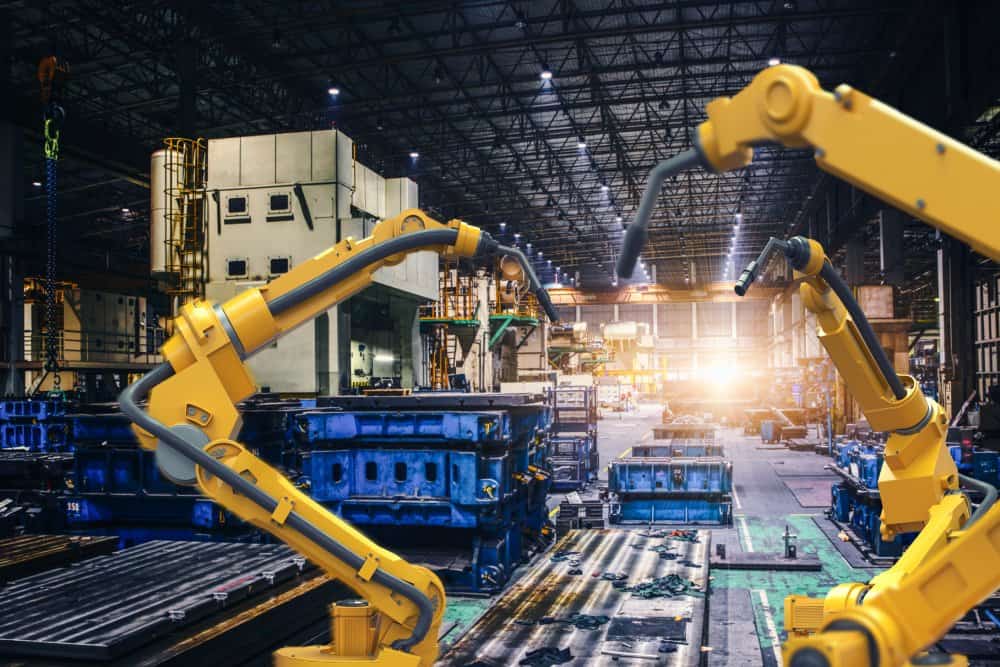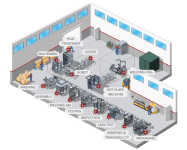In the past, adding workers to resolve operational problems was a viable solution for many businesses, but this isn’t the case today. Instead, automation is the solution to lengthening shifts and recent struggles to find employees. With automation, companies can increase efficiency and productivity without increasing labor expenses.
When choosing the right industrial automation equipment and systems for your application, you’ll need to take several variables into consideration. Learn more about what these are below.
Assess Your Automation Equipment Needs
Automation is a part of lean manufacturing principles, which aim to create efficient and repeatable processes. When deciding on an automation system to integrate into your operations, you will need to assess your operations as a whole using value stream mapping (VSM). VSM allows you to identify and keep track of every aspect of your manufacturing operations, from staffing to material volumes to production timelines. With the help of VSM, you’ll be able to minimize waste during manufacturing, making it as efficient and lean as possible.
When selecting the right automated assembly system, your manufacturing volumes and overall budget are the main factors influencing your decision. Typically, businesses integrate an automated solution to address specific challenges regarding product configuration or distribution. Normally automation opportunities show themselves up as bottlenecks in the plant space, where raw materials or materials in process start to pile up because of an inefficient process in the assembly line.
Semi-Automated vs. Fully-Automated Systems
The two primary types of automated systems are semi-automated and fully-automated systems. Each offers unique advantages for various applications.
Semi-automated systems provide an ideal solution for applications that rely on operator involvement to some extent but still benefit from improved efficiency. It’s best to install these systems if the production volume is small or if certain assembly processes are too complex for full automation. Even when a process can not be fully automated because of the characteristics of the components or the process, incorporating technology into the assembly process helps the operator prevent mistakes due to inexperience or burnout.
If semi-automated systems aren’t sufficient, companies may install fully-automated systems. These processes are ideal if products don’t depend on operator assistance and are compatible with automated feeding. Fully-automated systems also meet the needs of operations with high production volumes. Although some may argue that manual labor is more cost-effective than total automation, these systems come with a high return on investment in the long term.
Matching Automation Needs to Solutions
Before fully integrating an automated system into your operations, you may be able to take smaller steps to start. These initiatives could help you ease into automation before you invest in more comprehensive processes.
For example, a collaborative robot or cobot can perform automated tasks alongside operators. A facility may use autonomous loaders and vehicles to simplify the transportation of materials from one area to another. A camera-equipped robotic arm could inspect parts, enabling staff who are normally responsible for inspections to focus on other tasks. Another robotic arm could assist with loading and unloading parts to and from computer numerical control (CNC) machines, while human operators can perform more complex, technical tasks.
Industrial Robot Options for Automation
Different types of industrial robots can help automate a wide range of tasks. Each task that a facility needs to automate will determine which type of end-of-arm tooling (EOAT) you will require.
- Articulated Robots: These robotic systems feature multiple joints that allow for more flexibility of motion. Applications for these robots include welding, printing, material handling, packaging, metalworking, machine tending, laser cutting, tie belt application, glue application, staple application, etc. Almost any process that a human operation does now can be automated by a robot as long as the trajectory is always identical from one part to the other. Robots are not intelligent machines and will repeat exactly the same movements every time, this implies that the components have to be “automation quality” so that the variation from one part to the nex is minimal.
- SCARA Robots: Selective Compliance Articulated Robot Arm (SCARA) robots include two rotary joints to perform various assembly tasks. They can move along all three axes, but they are especially well-suited for lateral movement positioning and the assembly movement being vertical from top to bottom.
- Cartesian Robots: Also known as rectangular robots, Cartesian robots are less expensive than other systems and offer high levels of accuracy. They operate on the X, Y, and Z axes of the Cartesian coordinate system, allowing for vertical and horizontal motion on all three axes. Applications for these robots include drilling, 3D printing, storing, and packaging. Usually these types of robots are modular making it possible to have the X and Y axis servo controlled and the Z axis with a pneumatic cylinder or any combination of servo controlled and pneumatic movements.
- Delta Robots: These systems comprise jointed parallelograms that connect to a base, allowing them to pick up items and place them precisely. Their fast and accurate motions make them ideal for use in electronics, pharmaceutical, and food manufacturing processes. These robots are the fastest types of robots being able to make movements in fractions of a second. These robots are ideally suited for assembly operations with a vertical movement from top to bottom.
- Polar Robots: Also called spherical robots, polar robots consist of a linear joint and two rotary joints connected to a robotic arm. Their benefits include simple controls, efficient operations, and a long reach that make these systems suitable for many applications, including automotive parts assembly.
- Robotic Work Cells: For a more efficient automation system, consider installing an all-in-one robotic work cell unit. A robotic work cell makes it easy to get your operations up and running soon after installation. Companies can customize robotic work cells based on their unique needs across a range of applications.
Contact AMD for Custom Automated Equipment Solutions
For reliable automated equipment solutions, turn to the experts at Advanced Manufacturing Development (AMD). As a leading industrial automation equipment manufacturer, we’ll help you develop a custom system based on your application’s unique requirements.
Contact us today to learn more about our equipment models and other solutions, or request a quote to get started on a custom automation system.



